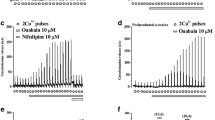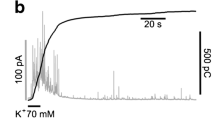Abstract
We tested lysophosphatidic acid (LPA), known to induce inositol phosphate generation and calcium signals as well as rearrangements of the cytoskeleton and mitogenic responses in fibroblasts, for its ability to activate phospholipase C in an exocrine cell system, the salt-secreting cells from the avian nasal salt gland. LPA (>10 nmol/l) caused the generation of inositol phosphates from membrane-bound phosphatidylinositides. The resulting calcium signals resembled those generated upon activation of muscarinic receptors, the physiological stimulus triggering salt secretion in these cells. However, close examination of the LPA-mediated calcium signals revealed that the initial calcium spike induced by high concentrations of LPA (>10 μmol/l) may contain a component that is not dependent upon generation of inositol (1,4,5)-trisphosphate (Ins(1,4,5)P3) and may result from calcium influx from the extracellular medium induced by LPA in a direct manner. Low concentrations of LPA (<10 μmol/l), however, induce inositol phosphate generation, Ins(1,4,5)P3-mediated release of calcium from intracellular pools and calcium entry. These effects seem to be mediated by a specific plasma membrane receptor and a G protein transducing the signal to phospholipase C in a pertussis-toxin-insensitive manner. Signaling pathways of the muscarinic receptor and the putative LPA-receptor seem to merge at the G-protein level as indicated by the fact that carbachol and LPA trigger hydrolysis of the same pool of phosphatidylinositol (4,5)-bisphosphate (PIP2) and mobilize calcium from the same intracellular stores.
Similar content being viewed by others
References
Benton, A.M., Gerrard, J.M., Michiel, T., Kindom, S.E. 1982. Are lysophosphatidic acids or phosphatidic acids involved in stimulus activation coupling in platelets? Blood 60:642–649
Borut, A., Schmidt-Nielsen, K. 1963. Respiration of avian saltsecreting gland in tissue slice experiments. Am. J. Physiol. 204:573–581
Bradford, M.M. 1976. A rapid and sensitive method for the quantification of microgram quantities of protein utilizing the principle of protein-dye binding. Anal. Biochem. 72:248–254
Coffey, R.J., Leof, E.B., Shipley, G.D., Moses, H.L. 1987. Suramin inhibition of growth factor receptor binding and mitogenicity in AKR-2B cells. J. Cell. Physiol. 132:143–148
Cook, S.J., Rubinfeld, B., Albert, I., McCormick, F. 1993. RapV12 antagonizes Ras-dependent activation of ERK1 and ERK2 by LPA and EGF in Rat-1 fibroblasts. EMBO J. 12:3475–3485
Das, A.K., Hajra, A.K. 1992. Critical micellar concentrations of palmitoyl dihydroxyacetone phosphate and 1-palmitoyl-rac-glycerol 3-phosphate. J. Biol. Chem. 267:9731
Durieux, M.E., Carlisle, S.J., Salafranca, M.N., Lynch, K.R. 1993. Responses to sphingosine-1-phosphate in X. laevis oocytes: similarities with lysophosphatidic acid signaling. Am. J. Physiol. 264: C1360-C1364
Fain, J.N. 1990. Regulation of phosphoinositide-specific phospholipase C. Biochim. Biophys. Acta 1053:81–88
Fisher, S.K., Hootman, S.R., Heacock, A.M., Ernst, S.A., Agranoff, B.W. 1983. Muscarinic stimulation of phospholipid turnover in dissociated avian salt gland cells. FEBS Lett. 155:43–46
Grynkiewicz, G., Poenie, M., Tsien, R. Y. 1985. A new generation of Ca2+ indicators with greatly improved fluorescence properties. J. Biol. Chem. 260:3440–3450
Haase, R., Wieder, T., Geilen, C.C., Reutter, W. 1991. The phospholipid analogue hexadecylphosphocholine inhibits phosphatidylcholine biosynthesis in Madin-Carby canine kidney cells. FEBS Lett. 288:129–132
Hildebrandt, J.-P., Shuttleworth, T.J. 1991. Inositol phosphates and [Ca2+]i signals in a differentiating exocrine cell. Am. J. Physiol. 261:C210-C217
Hildebrandt, J.-P., Shuttleworth, T.J. 1992. Calcium-sensitivity of inositol 1,4,5-trisphosphate metabolism in exocrine cells from the avian salt gland. Biochem. J. 282:703–710
Hildebrandt, J.-P., Shuttleworth, T.J. 1993. A Gq-type G protein couples muscarinic receptors to inositol phosphate and calcium signaling in exocrine cells from the avian salt gland. J. Membrane Biol. 133:183–190
Hughes, A.R., Takemura, H., Putney, J.W. 1988. Kinetics of inositol 1,4,5-trisphosphate and inositol cyclic 1∶2,4,5-trisphosphate metabolism in intact rat parotid acinar cells. J. Biol. Chem. 263:10314–10319
Jalink, K., van Corven, E.J., Moolenaar, W.H. 1990. Lysophosphatidic acid, but not phosphatidic acid, is a potent Ca2+-mobilizing stimulus for fibroblasts. J. Biol. Chem. 265:12232–12239
Kumagai, N., Morii, N., Fujisawa, K., Yoshimasa, T., Nakao, K., Narumiya, S. 1993. Lysophosphatidic acid induces tyrosine phosphorylation and activation of MAP kinase and focal adhesion kinase in cultured Swiss 3T3 cells. FEBS Lett. 329:273–276
Moolenaar, W.H., Jalink, K., van Corven, E.J. 1992. Lysophosphatidic acid: A bioactive phospholipid with growth factor-like activities. Rev. Physiol. Biochem. Pharmacol. 119:47–65
Morris, A.J., Waldo, G.L., Downes, C.P., Harden, T.K. 1990. A receptor and G-protein-regulated polyphosphoinositide-specific phospholipase C from turkey erythrocytes. J. Biol. Chem. 265:13501–13507
Putney, J.W. 1993. Excitement about calcium signaling in inexcitable cells. Science 262:676–678
Ridley, A.J., Hall, A. 1992. The small GTP-binding protein rho regulates the assembly of focal adhesions and actin stress fibers in response to growth factors. Cell 70:389–399
Shiono, S., Kawamoto, K., Yoshida, N., Kondo, T., Inagami, T. 1993. Neurotransmitter release from lysophosphatidic acid stimulated PC12 cells: involvement of lysophosphatidic acid receptors. Biochem. Biophys. Res. Comm. 193:667–673
Shuttleworth, T.J. 1990. Receptor-activated calcium entry in exocrine cells does not occur via agonist-sensitive intracellular pools. Biochem. J. 266:719–726
Shuttleworth, T.J., Thompson, J.L. 1989. Intracellular [Ca2+] and inositol phosphates in avian nasal gland cells. Am. J. Physiol. 257:C1020-C1029
Strathmann, M., Simon, M.I. 1990. G protein diversity: A distinct class of a subunits is present in vertebrates and invertebrates. Proc. Natl. Acad. Sci. USA 87:9113–9117
Takemura, H., Hughes, A.R., Thastrup, O., Putney, J.W. 1989. Activation of calcium entry by the tumor promoter thapsigargin in parotid acinar cells. J. Biol. Chem. 264:12266–12271
Tigyi, G., Miledi, R. 1992. Lysophosphatidates bound to serum albumin activate membrane currents in Xenopus occytes and neurite retraction in PC12 pheochromocytoma cells. J. Biol. Chem. 267: 21360–21367
Van Corven, E.J., Groenink, A., Jalink, K., Eichholtz, T., Moolenaar, W.H. 1989. Lysophosphatidate-induced cell proliferation: identification and dissection of signaling pathways mediated by G proteins. Cell 59:45–54
Van Corven, E.J., Hordijk, P., Medema, R.H., Bos, J.L., Moolenaar, W.H. 1993. Pertussis toxin-sensitive activation of p21ras by G protein-coupled receptor agonists in fibroblasts. Proc. Natl. Acad. Sci. USA 90:1257–1261
Van Corven, E.J., van Rijswijk, A., Jalink, K., van der Bend, R.L., van Blitterswijk, W.J., Moolenaar, W.H. 1992. Mitogenic action of lysophosphatidic acid and phosphatidic acid on fibroblasts. Biochem. J. 281:163–169
Van der Bend, R.L., Brunner, J., Jalink, K., van Corven, E.J., Moolenaar, W.H., van Blitterswijk, W.J. 1992. Identification of a putative membrane receptor for the bioactive phospholipid, lysophosphatidic acid. EMBO J. 11:2495–2501
Weltzien, H.U. 1979. Cytolytic and membrane-perturbing properties of lysophosphatidylcholine. Biochim. Biophys. Acta 559:259–287
Author information
Authors and Affiliations
Additional information
I would like to thank Prof. Dr. I. Schulz for providing lab space and some of the equipment used in this study and Prof. Dr. T.J. Shuttleworth for his helpful comments on a draft of the manuscript. This study was supported by the Deutsche Forschungsgemeinschaft (Hi 448/ 2-1 and 2-2).
Rights and permissions
About this article
Cite this article
Hildebrandt, J.P. Lysophosphatidic acid induces inositol phosphate and calcium signals in exocrine cells from the avian nasal salt gland. J. Membarin Biol. 144, 49–58 (1995). https://doi.org/10.1007/BF00238416
Received:
Revised:
Issue Date:
DOI: https://doi.org/10.1007/BF00238416




